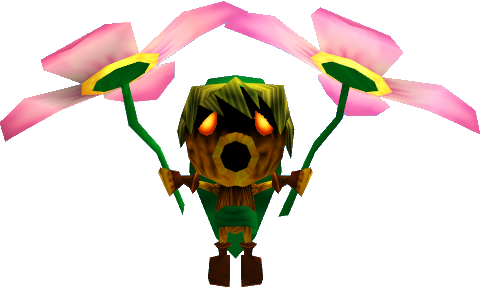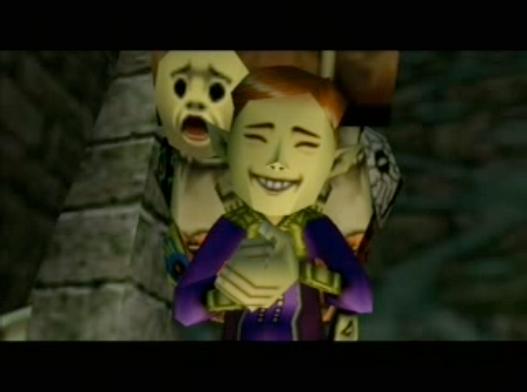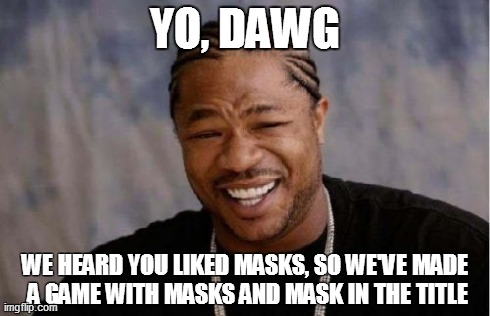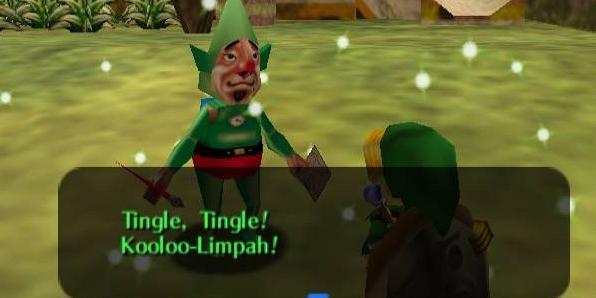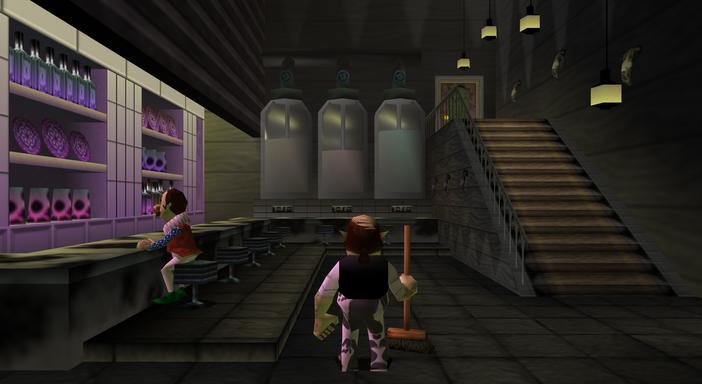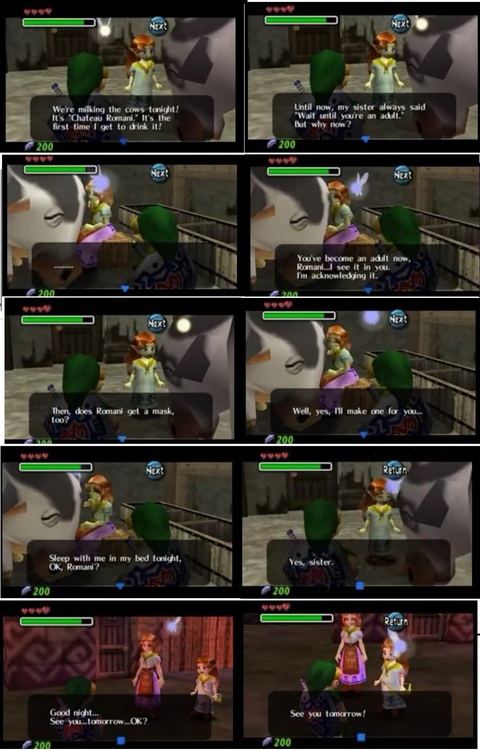Posted on August 21, 2014
You were just having a little nightmare…
I haven’t really written a straight-up review of anything since my first year at Saint Thomas University when I wrote album reviews for the Brunswickan, which was actually the newspaper for the other university on campus – the University of New Brunswick. They were just two-or-three paragraph blurbs about various nü-metal albums of the day, and weren’t exactly the most well thought-out things I’ve ever written.
In any event, this review of Majora’s Mask may get a bit long-winded, but it needs to be written. The game has garnered a lot of attention as of late – you know, because Internet – and I felt the need to at least get my opinions on the game out there.
The first aspect of gameplay I need to talk about is right there in the game’s title. Masks played the role of “fun little side-quest” in Ocarina of Time, and collecting them all really wasn’t high on my Give-A-Hoot List. Sure, you might’ve gotten some different responses from NPC’s when you spoke to them, but that wasn’t nearly enough to motivate me to seek out all eight of them.
After chasing Skull Kid through the forest in Majora’s introduction sequence, you’re given some not-so-subtle hints that masks play a much bigger and more functional role this time around. To begin with, you’re not Link… well, you are, but Deku Link honestly feels like something out of another game entirely.
At the end of a tutorial-like segment to get acquainted with your special abilities, you meet the character responsible for this whole shemozzle at the base of Clock Town’s main tower – the Happy Mask Salesman. Majora’s Mask was in that massive backpack of his before he was ambushed by the aforementioned Skull Kid, resulting in the evil mask being stolen.
The game’s title + assuming\hoping you don’t have to play as Deku Link for much longer + an introductory character with a huge bag of masks begging you to get an important mask back = “gee I wonder if masks play an important part in this game?”
So that’s the first part about this game that bugged me on my first (incomplete) playthrough – sure, the idea of changing into characters was kinda fun, but don’t take a sort-of-boring thing from the first game and make it the next game’s MAIN THING!
Anyway, counting the three main form-altering masks (Deku, Zora and Goron), there is a grand total of 24 wearable masks that Link can find which grant him special abilities. For example, one mask gives him the ability to bomb things by running up to them and pressing a button, while another alerts him to the nearby presence of fairies to regenerate health.
Some masks don’t serve much of a purpose, other than to help complete some side-quest involving an NPC. Collecting all of them can be quite the painstaking process, sometimes involving long waits (even with the in-game clock sped up), and the payoff at the end of the game is barely even worth it.
Unfortunately, I was already somewhat disinterested before changing back to Link’s normal form. Like I’ve done with many other games, I eventually came back to it and soldiered on. Surely, there must be more to it than that.
The other big thing about Majora’s Mask is its three day cycle. Clock Town and Termina’s residents are fearful of the moon looming overhead, and for good reason – not only does it have a freaky face on it, but it’s also getting closer and closer with each passing moment. In just three days, just as the “Carnival of Time” is in full swing, Mr. Moon will crash into the Earth (or whatever planet it takes place on) and end life as they know it.
The in-game clock is definitely one of the most interesting aspects of the game. At first, I thought it might be similar to a Mario game or any other platformer with a time limit, and that I’d feel pressure to complete tasks as quickly as possible and only succeed in the nick of time. Thankfully, that’s not the case.
Though the length of “one day” lasts about 18 minutes, there are two songs Link can learn on his Ocarina to change the flow of time – one to slow the clock down to half-speed, and one to speed it up to twice as fast. If you’re like me and enjoy taking your time to explore, you’ll be playing the “half-time” melody about as much as you played Zelda’s Lullaby in Ocarina of Time.
At the very end of the first act, you learn another song that saves the game and takes you back to the first day in the cycle. Here’s where it gets a bit weird…
From the very beginning of the game, you have a very clear goal – to save the world from impending doom. To do this, you must summon the “Four Giants” referred to at the beginning of the game… using past Zelda experiences, you can fairly easily deduce that each of the Four Giants are found at the end of four separate dungeons.
What’s strange is the side-quest-like things you have to do in order to get to these dungeons. For example, to get to the Snowhead Temple, you have to do the following;
Visit the Goron Village to trigger a conversation with Kaepora Gaebora…
Follow the talking owl on an awkward invisible platform chase…
Get the Lens of Truth at the end of the chase…
Go back to solid ground and use the Lens to talk to the ghost of the Goron Darmani…
Follow him on a chase all the way back through the way you entered the area…
Scale a tall cliff to enter the cave in which Darmani resides to get the Goron Mask…
*phew*
Go all the way back to the Goron Village and enter the main hall as Goron Link…
Speak to the Goron Child and find out why he’s crying…
Seek the Goron Elder, only to find he’s encased in ice…
Look around for some kind of hot substance to melt the ice…
Find some, melt the ice and speak to the Goron Elder…
Learn the *first part* of the Goron Lullaby…
*deep breath*
Return to the Goron Shrine and play what you know for the child…
Learn *the rest* of the Goron Lullaby from the child and put him to sleep…
Travel through the treacherous Snowhead Mountain path…
Use the Lens of Truth to be able to see the somehow invisible Giant Goron in front of the temple…
Play the Goron Lullaby to put the Giant Goron to sleep, who then falls off to the side to reveal the temple’s entrance.
Gah!
While I certainly understand the concept of changing the way you progress and get to the next objective, they felt like menial chores that would normally be reserved for side quests. Once again, it was something that was once optional but was now necessary.
On top of all that, one of the most interesting aspects of Zelda games up until then was the dungeons themselves – Majora’s Mask has four fairly challenging and well thought-out temples before the game’s final act, and that’s it. The rest of the game’s fortresses in-between dungeons aren’t too bad, but feel a bit tacked-on; sort of like Ocarina’s Bottom of the Well and Gerudo Fortress stages.
Here’s the flipside to all that side quest-like stuff the game treats as the main attraction – in terms of the writing, the situations these characters are faced with and how you get to help and interact with them, it’s among the most heart-felt and emotional stuff in the entire series. No Zelda game does it better, if you ask me.
Sure, the gameplay in dealing with some of these situations can be a little on the bland side, but even those little and seemingly meaningless interactions with the Gorons give you that warm and fuzzy feeling inside. “I helped make the end of the world not-so-crappy for you! Hooray!”
Some of the subject matter can actually be pretty dark, which is another thing people enjoyed. Nintendo games have often shied away from topics like religion, and are quite well-known for censoring any reference to tobacco or alcohol. One challenging sequence deals with one of those things, albeit indirectly.
Romani Ranch is somewhat like Ocarina’s Lon Lon Ranch in that it’s where you find Epona (again). The Ranch is also the main provider for Clock Town’s “Milk Bar”, which is a nightclub-like area Link can only get into with special membership.
The Ranch’s caretakers are a little girl by the name of Romani and her adult sister Cremia. Romani says that her big sister won’t let her try the Ranch’s signature product – Chateau Romani – until she’s old enough to drink it.
However, if you visit them on the Final Day, Romani is delighted at the prospect that her sister is finally letting her try the Chateau Romani later that evening. Speaking to Cremia reveals that not only has the adult sister accepted that there is no hiding from the end of the world, but that there’s no reason to tell her little sister the fate that awaits Termina and its residents.
Cremia’s allowing Romani to drink Chateau Romani – an obvious nod to many wines from France having the word “Chateau” in them – allows the older sister to acknowledge the younger one’s passage into adulthood. Furthermore, it’s believed by some game theorists (yep, they exist) that Cremia intends to get Romani intoxicated enough that she won’t be able to feel the inevitable chaos that comes with the Moon collision.
My main gripe about these amazing little interactions is the fact that you constantly have to go back to the First Day. If you help someone out, get something out of it, then save the game, it essentially undoes everything you just did.
If you help Romani get rid of the aliens at the Ranch (long story) and then happen to visit her later on, she’ll tell you all about her plight all over again. It gave me a helpless feeling, one that came with the thought that no matter how many people I try to help, I just end up having to go back and un-do everything to help someone else – usually myself.
Majora’s Mask changes things around a bit from a gameplay perspective and makes you connect with its characters in a way that had never really been done in a Zelda game before. Truth be told, the only other time I felt an awww-inducing emotional moment was during Wind Waker.
When Link leaves Outset Island for the first time and his grandmother watches from his front porch, I’ve gotta say… that got me.
In the end, I absolutely suggest you play Majora’s Mask if you haven’t already. It has some of the best storytelling in any game in the series, as well as some of its most memorable music. It’s not for everyone, but there’s only one way for you to find out if it’s up your alley.
Verdict – DO IT UP!


